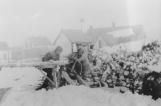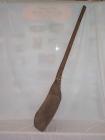1
In his description of Long Island in 1604, Samuel de Champlain made note of plentiful quantities of pine and birch. Wood was an essential resource on the Islands ever since settlement began in earnest in the 1780's. Circa 1900, water powered saw mills were located in both Freeport and Tiverton. In Tiverton the "mill pond" is remembered to be located at the bottom of the hill by George Outhouse's home(Tracey Leeman 2003). Freeport saw the establishment of a "water mill" at the head of the brook near Samuel Young's house, below the
existing dam. Tales of boards over 3 feet wide being cut here are told.
In later years, there were two sawmills in Central Grove, Tibert's and Pyne's.
Through the years, residents turned to their woodlots when they needed materials to build shelter: houses, outbuildings and fences; transportation: boats, wagons and sleds,as well as methods of survival: tools,fish weirs and even water pipes. Of course wood was needed to cook their food and heat their homes. Older residents can still recall the time when every dooryard had a neatly stacked woodpile, and when boughs were piled around the base of the houses to provide insulation during the winters. Trees were felled with cross-cut or buck saws, and teams of oxen hauled the logs from the woods on sleds. Memories of up to five teams of oxen and a horse team working one area of woodlot, are recalled. This effort would supply many men with work and houses with fuel.
Less than half a century ago every village had a gas-powered mobile sawmill that would be taken from house to house to cut the logs to more manageable size. To this day, woodlots (still known by their assigned numbers - e.g. "#5", or "#19") provide fuel and income, although nowadays black spruce has by and large replaced the variety of species which covered the Islands when they were first settled.
3
In early years water pipes were constructed of hollowed out wood sections, especially made to fit snugly inside one another These pictures show the inventive way the pipes were constructed.9
Cross cut saw used by two men to saw down larger trees.1940
Islands Museum, Tiverton, Nova Scotia, Canada

11
Arthur Moore tells us about his days cutting wood:Brenda: Where did you cut wood?
Arthur: Well, up on 23, we had to cut wood on 23. That's what my grandfather owned, 23. I used to go up with my grandfather and then after I got older I cut wood with this person and that person.
Brenda: But after you cut wood with your grandfather, up on 23, that's up the island quite a way, isn't it?
Arthur: Oh yeah.
Brenda: Then you had to drag it all down here?
Arthur: Had an ox team. Hauled it home on a sled in the winter. Came down the meadow road.
Brenda: Down through the woods - the meadow road up here half way up this road here.Then you'd have to split it after you got it home.
Arthur: Saw it up then split it with an ax. Then you had wedges, hardwood wedges to wedge them apart.Well, you'd go in the woods and cut a load of wood for a horse - .75 cents. With a pole ax.
Brenda: And that would take you how long?
Arthur: You might get two load a day. But there wasn't no short stuff. Sometimes the whole length of the tree, you had to leave them. They didn't take no 8 foot then, 10 or 12 feet.
Brenda: Who did you cut for?
Arthur: Alton MacNeill and Charlie Young.
Brenda: And they paid you seventy-five cents a load. And what time would you start in the morning? I suppose early?
Arthur: Well, you'd leave about 8 o'clock in the, morning, start walking up to 5 for Alton MacNeill. Alton MacNeill owned up on five there, Blair MacNeill owns it now. We used to cut there then haul it down the brook. Haul the wood down the brook with a horse team.
Brenda: And what time would you be through? Would you work until dark pretty much?
Arthur: No, no. Around four or five o'clock and you'd walk home.
Brenda: But after working that hard all day, then you had to walk home. And that was dangerous work too, that would have been dangerous work in those days. Didn't have any chain saws and all that convenience stuff then.
Arthur: No chain saws. All you had was a pulp saw and a cross cut - two fellows on it sawing big trees down.
From an interview with Arthur Moore conducted by Brenda Teed for Passages
12
A relica of a 'bobsled' which carried a load of wood, and was pulled by an ox team.1940
Islands Museum, Tiverton, Nova Scotia, Canada

13
Delivering a load of wood destined to be a family's winter fuel.1930
Westport, Nova Scotia, Canada

14
St. Clair Cann using his portable saw to cut wood for household fuel.1930
Westport, Nova Scotia, Canada







